 |
Krasny Yar Fortress
Krasny Yar, Samarskaya Oblast, Russia
...and the Novo-Zakamskaya Defensive Line
|
|
 |
Constructed: 1732
Used by: Russia
Conflict in which it participated:
Pugachev's Rebellion
|
In the beginning, there was Rus. The Varangians, a group of trader slash mercenaries slash pirates emanating from Scandanavia, worked their way into Slavic lands in the 8th and 9th century AD by way of the region's many navigable rivers. Varangian prince Rurik (830-879) established himself at Novgorod (literally "new fortification"), near the source of the Volkhov River, around 862.
|
 |
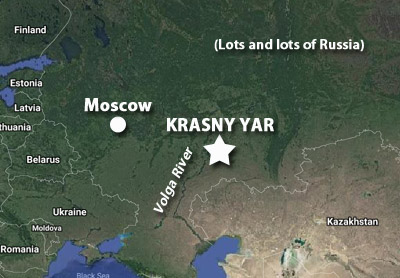 |
|
By the 12th century, Rus had expanded from the Baltic to the White Sea. Anyone attempting to maintain and/or expand an empire in this part of Asia had to contend with constant incursions by numerous nomadic tribes with such entertaining names as Pecheneg, Kipchak and Porkpie (I made the last one up). How does one solidify one's hold on conquered territory from the vicious Porkpies? Yes, by fortification. You have been paying attention. Individual forts are cool things, but insufficient to protect entire borders...so these prototype Russians became masters of the fortified line.
|
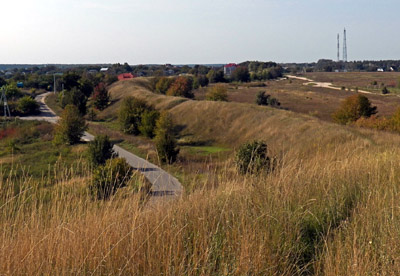
The "Serpent's Shaft" near the village of Ivankovichi, not far from Kiev. This line might date back as far as the second century BC. |
 |
When building a fortified line, it makes sense to take advantage of natural obstacles such as rivers, of which this part of Russia has in abundance. Such fortifications didn't start with the Rus: The Zmiev Walls, also called the Serpentine Trees, were a series of defensive earthwork walls that slithered along the Dneiper River and its tributaries south of the city of Kiev.
Precisely when these fortifications were built, by whom and for what specific purpose all seem to be at issue, as they may date back as far as the second century BC, which was a time before Wikipedia was anywhere near as authoritative an informational source as it is today. |
|
|
The Fortified Line of our Current Interest, however, is the Novo-Zakamskaya defensive line. The Old Zamaskaya Line was completed in 1656, and was an extension of yet another fortified line, the Simbirsk Zasechnoy. Each successive line marked an effort to aggressively settle regions ever southward into lands already loosely inhabited by people who didn't take kindly to interlopers, and each line was dotted with new city-fortresses populated by exiles, semi-voluntary relocatees from nearby villages, and military units. Cossacks patrolled the length of the lines. When new lines were built to replace the old, these settlements were "emptied" so as to repopulate the new.
But an entire defensive line, hundreds of miles long, could never be defended everywhere. Those nomadic tribes for whose containment these lines were built regularly pierced them and went a-lootin' and a-raidin'. Constant maintenance and vigilance was needed on the part of those heroic line-builders...as well as a readiness to keep expanding those lines.
|
Tsar of the Russian Empire Numero Uno, Peter the Great (1672-1725), ordered the construction of this novo line of defense. Plans for this massive undertaking took a while to coagulate, and it wasn't until 1731, under the administration of Empress Anna (1693-1740), that work commenced.
Always sensitive to the individual needs of its peasants, the Russian Senate decreed the "allocation" of 3,000 residents of the city of Kazan, who would serve as the initial workforce for this project: They were to be paid 30 altyns a month for their service, which translates to three kopeks, which today amounts to .0045¢. What was a living wage for a Russian peasant in the mid-18th century? Maybe they were living like kings on 30 altyns a month! More likely, 30 altyns a month allowed them to live like Russian peasants.
|
 |
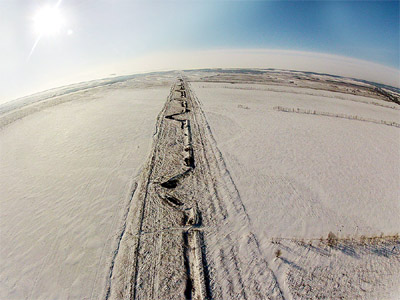 The Novo-Zakamskaya Line, as viewed recently from a drone. Yes, I realize that all we've been looking at thus far on this page have been pictures of vague scratchings in Russian dirt, but bear with me. Vladimir Smerkalov's drone-happy visit to Krasny Yar and his resulting blog post are the source of these fantastic pictures! The Novo-Zakamskaya Line, as viewed recently from a drone. Yes, I realize that all we've been looking at thus far on this page have been pictures of vague scratchings in Russian dirt, but bear with me. Vladimir Smerkalov's drone-happy visit to Krasny Yar and his resulting blog post are the source of these fantastic pictures! |
|
Protection of this happy crew was detailed to a unit of "former servicemen," retired military men who were a major part of the population scheme of these fortified lines. Guess you're not as retired as you thought, are you sergeant? Also present were plenty of Cossacks, of course, which were good for defending the workforce and compelling it to remain a workforce!
The Novo-Zakamskaya Line would stretch for some 200 miles, from the Alekseevskaya Fortress on the Samara River, northeast along the Rivers Sok and Kondurcha, and ending at the Kichuysky Redoubt, at the little town of Kichuy. The Novo-Zakamskaya's headquarters was in the city of Samara, at the line's southern extent.
|
|
The eleven bastions of the Novo-Zakamskaya Defensive Line. Click on each to see what it is!
|
 |
There were a series of forts and redoubts along the line, eleven of which remain today in varying degrees of decomposition. From north to south they are: (Click on each to see a pic in a new tab)
Of these survivors, Krasny Yar Fortress has certainly survived in the best shape, which is why it in particular is the starfort of our current interest. All of these fortifications were constructed in the early 1730's, and thus they all have a similar story, so Krasny Yar's story represents them all. At least that's what I'm telling myself, so I don't have to do a page for each of them. |
|
|
Our fort's name means "red jar," a reference to the red clay of bank of the Sok River, at which it's sited. A "yar" is a steep riverbank. There doesn't appear to be anything steep near the fort now, but steepness is as steepness does.
The Novo-Zakamskaya Defensive Line was "populated" with 4212 people from 1734 to 1736, around 4,000 of whom were military troops of one stripe or another. Duty at this windswept outpost wasn't popular, despite many soldiers being granted from 22 to 55 acres of land, as part of the colonization scheme of this adventure. A good deal of time and effort was spent hunting down escaped privates, which would normally be considered deserters, but in this case they sure seem like escapees.
When at the height of its powers, the Novo-Zakamskaya was nearly 200 miles long, 3/4 of which length was an earthwork wall of about 4 meters in height, with a ditch afront. Every 300 meters or so the wall juts out in an "edit," which makes the line look a bit like a heartbeat monitor from above...each could serve as a defensive strongpoint in a pinch. Forts or redoubts occurred every 10 to 12 kilometers. Ultimately around 15,000 peasants worked on the line's construction.
|
And then it was over! Plans for a new defensive entity, the Orenurg Line, got underway in 1734, and the Novo-Zakamskaya was declared officially unnecessary in 1737. Everybody who had been relocated to man the Novo-Zakamskaya just a few years previously was uprooted and sent southeast to man this new line. Maybe the transient nature of these postings was why free land grants weren't particularly appealing to these soldiers!
But just because a starfort isn't on the front lines any longer doesn't mean it ceases to exist, and in the case of Krasny Yar Fortress, nor did the town that had grown up around it...which means that the settlement scheme behind all of this worked! Way to go, 18th-century Russia!
|
 |
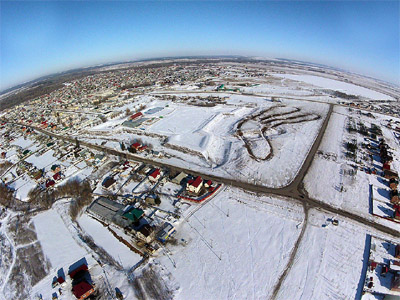 I'm all for the modern repurposing of starforts, which is a vast improvement over bulldozing them, but...21st century scallawags on motobikes, cheerfully tearing up an 18th century starfort's ravelin? That's not repurposing, that's two-wheeled vandalism. |
|
One thing that 18th century Russia did not do well was treat its serfs. Serfs never had it easy, but various political reforms overseen by Peter the Great and Empress Catherine the Somewhat Equally Great (1729-1796) made things much worse for those on the lowest rungs of Russian society. Some fifty peasant revolts took place in Russia in the 1760's, but the culmination of these was the Peasants' War of 1773-1775, also known as Pugachev's Rebellion or the Cossack War, headed by Lemelyan Pugachev (1742-1775).
Pugachev was a Cossack who took advantage of the Empress Catherine's recent overthrow and possible murder of her husband, Emperor Peter III (1728-1762), by pretending to be Peter III and thus inspiring his fellow Cossacks, and peasants, to insurrection against the wicked usurper Catherine. Given the unrest at the time, it couldn't have been difficult to convince peasants to insurrect!
|
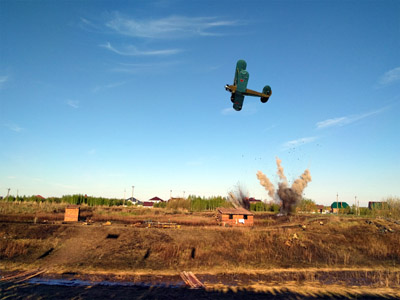 From some reenactment event in March of 2018: If you look carefully, you can see a bunch of guys in WW2 Soviet uniforms hunkered down as Krasny Yar fortress is bombed by what I will cautiously identify as a Polikarpov Po-2. Try getting away with that much of a reenactment in the United States! From some reenactment event in March of 2018: If you look carefully, you can see a bunch of guys in WW2 Soviet uniforms hunkered down as Krasny Yar fortress is bombed by what I will cautiously identify as a Polikarpov Po-2. Try getting away with that much of a reenactment in the United States! |
 |
Pugachev's hordes enjoyed a good deal of success early in the war. In 1773 they captured and occupied Samara, at the southern end of the Novo-Zakamskaya Line. In mid-January of 1775, the insurgents captured Krasny Yar Fortress. Was there anybody there for the insurgents to capture it from? Unclear. As the Novo-Zakamskaya Line was no longer the front line in Russia's program to consume Asia, it is unlikely that Krasny Yar had been garrisoned in any meaningful way when the Pugachevites came a-knockin'.
A battle betwixt Pugachev's and Tsarist forces took place on January 22, 1774 near our starfort. An insurgent detachment led by Fedor Ivanovich Derbetev (1740-1774) was defeated in this battle, losing 120 dead, 40 prisoners and five of its six guns.
|
|
|
Derbetev only made it a few more months, dying after being wounded in another battle in May of 1774. By the end of that year, Catherine's forces were fully in the field, and Pugachev's rebellion was crushed. The man after whom the rebellion is known was betrayed by his fellow Cossacks, and was (understandably) decapitated and drawn and quartered in Moscow in January of 1775.
|
Little information seems to be available about Krasny Yar Fortress after the end of the Pugachev Rebellion, although all one needs to do is look at images of the other forts of the Novo-Zakamskaya Line to see what 250 years of neglect will do.
Krasny Yar Fortress fared much better than its forted brethren, however, thanks to the Soviet Union. In the Soviet era Krasny Yar Fortress was converted into a sports slash entertainment complex, featuring a soccer field, hockey rink, running track, playground and various entertaining slash sporty buildings. An unfortunate additional attraction is a series of motobike tracks, one of which uses the fort's ravelin as a fun thing to destroy with one's knobby motowheels.
|
 |
 Sports! Entertainment! And the bustling metropolis of Krasny Yar. Sports! Entertainment! And the bustling metropolis of Krasny Yar. |
|
A thousand thanks to fellow starfort enthusiast Jacob Bogle, creator and maintainer of the stellar Fortress Earth Project, who alerted us to Krasny Yar Fortress!
|
|
|
|
|
|
 |




